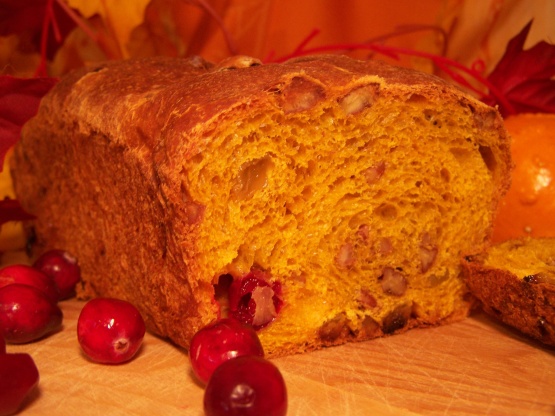Ingredients
-
2 2/3-3 cups bread flour (don't use all-purpose!)
-
1 teaspoon cinnamon
-
1/2 teaspoon grated nutmeg
-
1/2 teaspoon salt
-
2 tablespoons tepid water (80 - 90 degrees F)
-
2 teaspoons active dry yeast
-
5 tablespoons unsalted butter, room temp
-
1/3 cup sugar
-
1 cup pumpkin puree or 1 cup butternut squash, fresh or canned solid packed
-
3/4 cup walnut pieces, toasted
-
2/3 cup cranberries (if frozen, thaw and pat dry)
-
1 large egg, room temp
-
2/3 cup plump golden raisins or 2/3 cup dark raisin
Instructions
- Note: This bread has an overnight rise.
- [b]Mixingand Kneading[/b]: whisk 2 2/3 cup flour with the cinnamon, nutmeg and salt.
- Set aside.
- Sprinkle the yeast on the water and allow to bloom about 5 minutes.
- In a mixer with the paddle attachment, cream the butter and sugar on medium speed until light.
- Add the pumpkin and egg and beat until well blended.
- Don't be concerned if the mixture looks curdled.
- Set the mixer to low speed and add the yeast, then begin to add the dry ingredients about 1/2 cup at a time.
- As soon as the mixture starts to form a dough that comes together, scrape the paddle clean and switch to the dough hook.
- If your dough doesn't come together (it might be because the pumpkin had too much liquid) add a bit more flour, a tablespoon at a time, until it does.
- Mix and knead the dough on med-low spped for 10-15 minutes, scraping down the bowl and dough hook now and then.
- At the start, the dough will look more like a batter than a dough, but as you continue to work, it will develop into a soft, very sticky dough that will ball up on the hook.
- The dough develops much the way brioche does.
- With the machine on low speed, add the walnuts and raisins, mixing only until incorporated, about 1 minute.
- Add the cranberries and mix as little as possible to avoid crushing them, although some cranberries will pop and stain a patch of the dough red; think of this as charming and proceed.
- [b]FirstRise[/b]: scrape the dough into a lightly buttered large bowl, cover tightly with plastic wrap and set aside at room temperature to rise until nearly doubled- 2-3 hours.
- [b]Chillingthe dough[/b]: when the dough has doubled, fold it over on itself a couple of times to deflate it, wrap it tightly in plastic and refrigerate overnight.
- [b]Shapingthe dough[/b]: at least 6 hours before you want to begin baking, remove the dough from the refrigerator.
- Leave it covered, in its bowl, until it reaches at least 64 degrees F.
- on the insta-read thermometer.
- This will take as long as 3-4 hours- don't rush it.
- If you don't have an insta-read, look for the dough to be slightly cool and just a little spongy.
- Lightly butter 2 loaf pans.
- Working on a lightly floured surface, divide the dough in half and pat each piece of dough into a rectangle, keeping the short end facing you.
- Start at the top and roll the dough toward you and seal the seam by pressing it with your fingertips.
- Seal the ends, then place each roll in the pans, seams down.
- [b]SecondRise[/b]: cover the pans lightly with a kitchen towel and allow to rise at room temperature for 1 1/2 to 2 hours or until the dough has nearly doubled.
- It will rise to just above the rim of the pans.
- [b]Baking[/b]:preheat the oven to 350 degrees F.
- Bake about 50-55 minutes or until deep golden.
- Remove the pans to cooling racks.
- After resting 5 minutes, turn the loaves out of the pans to cool to room temp.
- The breads can be kept at room temperature for a day or two or frozen, wrapped airtight, for up to 1 month.
- Thaw, still wrapped, at room temp.
- NOTE 1: I have made this bread in small loaf pans and given them as gifts.
- They will bake in about 30 minutes if formed into the small loaves.
- NOTE 2: The rising times are approximate.
- They definitely rise on the longer side of the time-table, but whatever you do, dont' rush the rising.
- Give yourself 2 full days to make this.
- But- the result will be totally worth it.
